Affiliate disclosure: This post may contain affiliate links. Please see our Privacy Policy.
Sweet potato slips are tiny sweet potato sprouts that are planted to grow more sweet potatoes. Unlike regular potatoes, where the whole tuber is planted, sweet potatoes are grown from slips without planting the actual sweet potato.

Growing sweet potatoes isn’t quite the same as growing regular potatoes, and you can’t just plant whole sweet potatoes in the soil and expect a crop. Planting whole sweet potatoes is a recipe for mold and rot, as most of them will just spoil rather than grow.
In some locations with the perfect temperatures and soil conditions that might just work, and I did on occasion have a sweet potato plant thrive in my compost heap in California. That’s an exception though, as it is technically possible in hot dry locations. Still, that’s not exactly the best way in any case, as a single sweet potato is capable of growing into dozens of individual plants (rather than just one).
Generally, sweet potatoes are grown from what’s known as “sweet potato slips” which are rooted sprouts. Most people buy sweet potato slips by ordering them from seed companies in the spring (or early summer in cold locations). They can be expensive, and the tender young plants often don’t do well in shipping.
Growing your own sweet potato slips is easy, and not really any more difficult than growing your own seed starts. You’ll be able to get your plants started earlier, save a bit of money and have fun in the process.
A single sweet potato can grow literally dozens of sweet potato slips, enough to fill a large garden with plants. It doesn’t take much to get started, just a sprout-y old sweet potato from the pantry will do. (Or a fresh one that you can encourage to sprout, either way.)
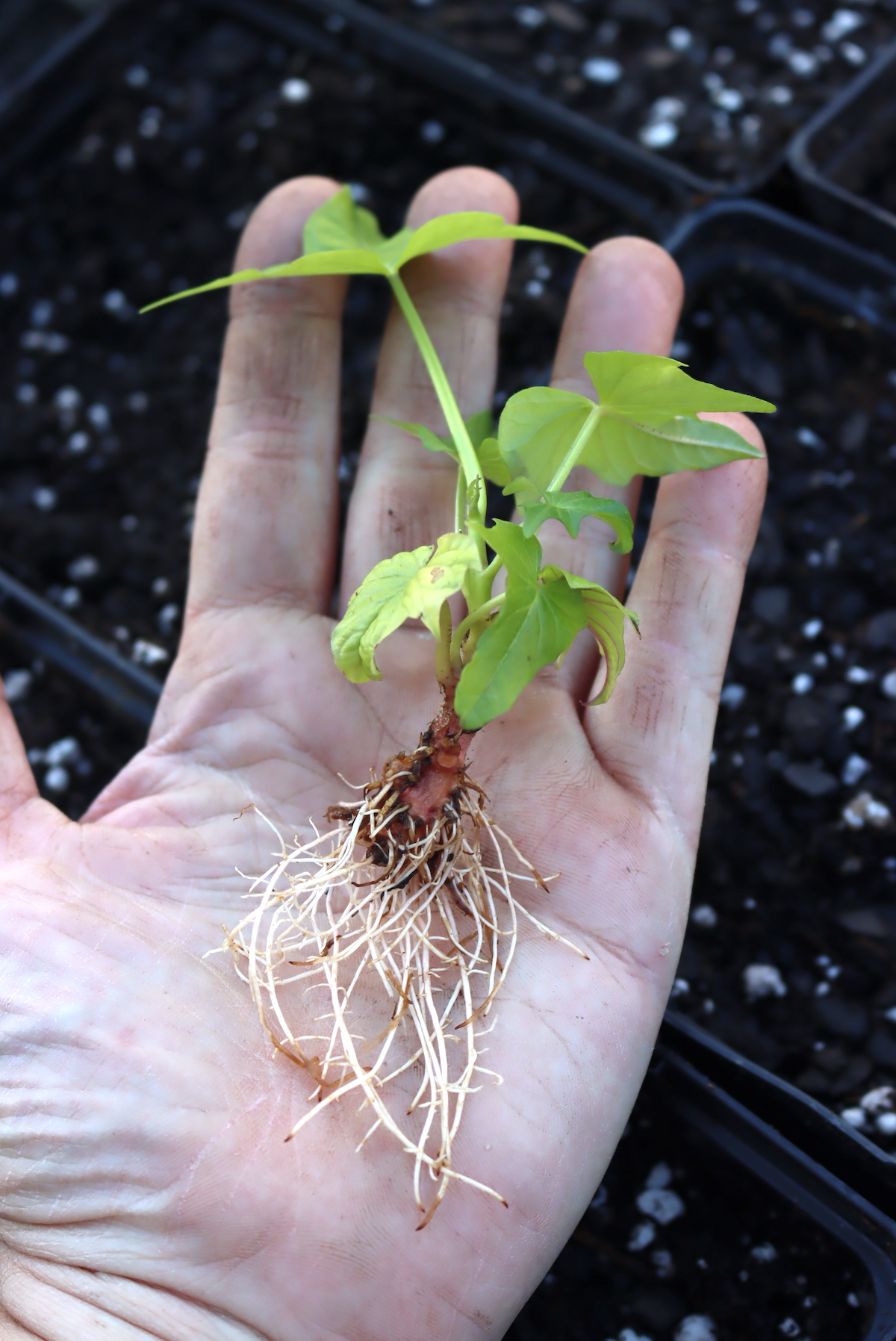
When to Start Sweet Potato Slips
It takes about 2 weeks to sprout a sweet potato, in ideal conditions. Once you have sprouts, sweet potato slips take about 6 to 8 weeks to mature. Since they’re a warm-season crop, they are not planted outdoors until 2 weeks after the last frost.
That means you’ll need to start about 6 to 8 weeks before the last frost in your area to have slips ready on time.
If we want to grow sweet potatoes the next year (and haven’t grown any the previous year), we’ll plan ahead. We generally buy a crate of organic sweet potatoes when they go on sale around Thanksgiving or just before Christmas. It’s one of the ways we save money on groceries each year since they’re usually half-price at that time of year.
The sweet potatoes will keep most of the winter at room temperature, but by late winter they’re starting to sprout. It’s usually right around the perfect time, roughly 2 months before our last frost.
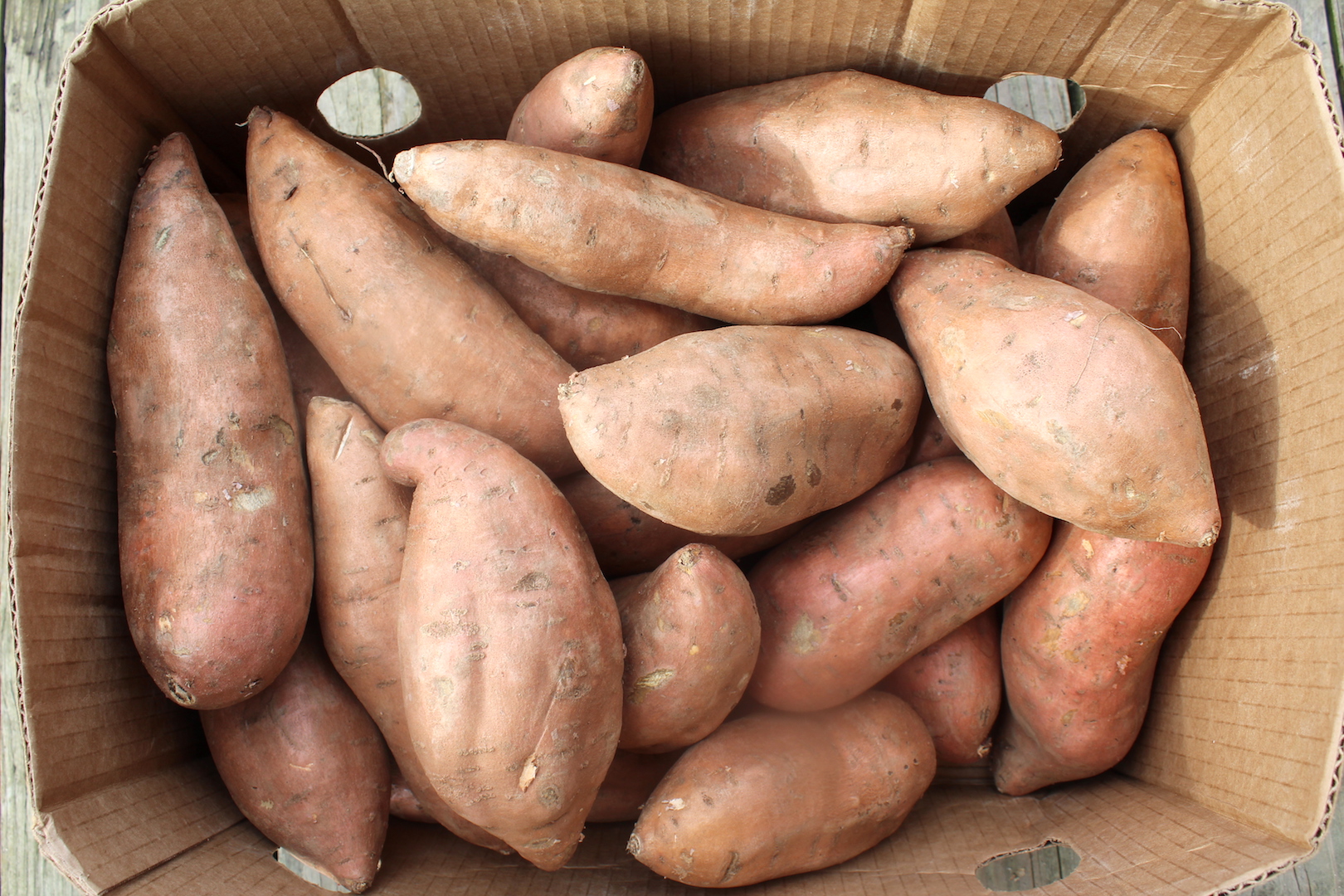
Sprouting Sweet Potatoes
The first step in growing sweet potato slips is sprouting sweet potatoes. If you have organic sweet potatoes that aren’t treated with germination inhibiting chemicals, this often happens on their own in storage.
Make sure you buy sweet potatoes well ahead of time, and store them for 6 to 8 weeks in a room-temperature location (not cold storage).
Unlike potatoes, which are stored in cool root cellar environments, sweet potatoes are a hot climate crop that likes room temperature storage. If you have dry winters, that works well and they’ll keep for many months without sprouting.
In our humid Vermont climate, they start to sprout on their own in late winter. Once I see the little sprouts I’ll pull them out of the pantry and set them on a sunny windowsill. The sprouts will be “bleached” since they’re stored without light, but they’ll green up quickly in the light.
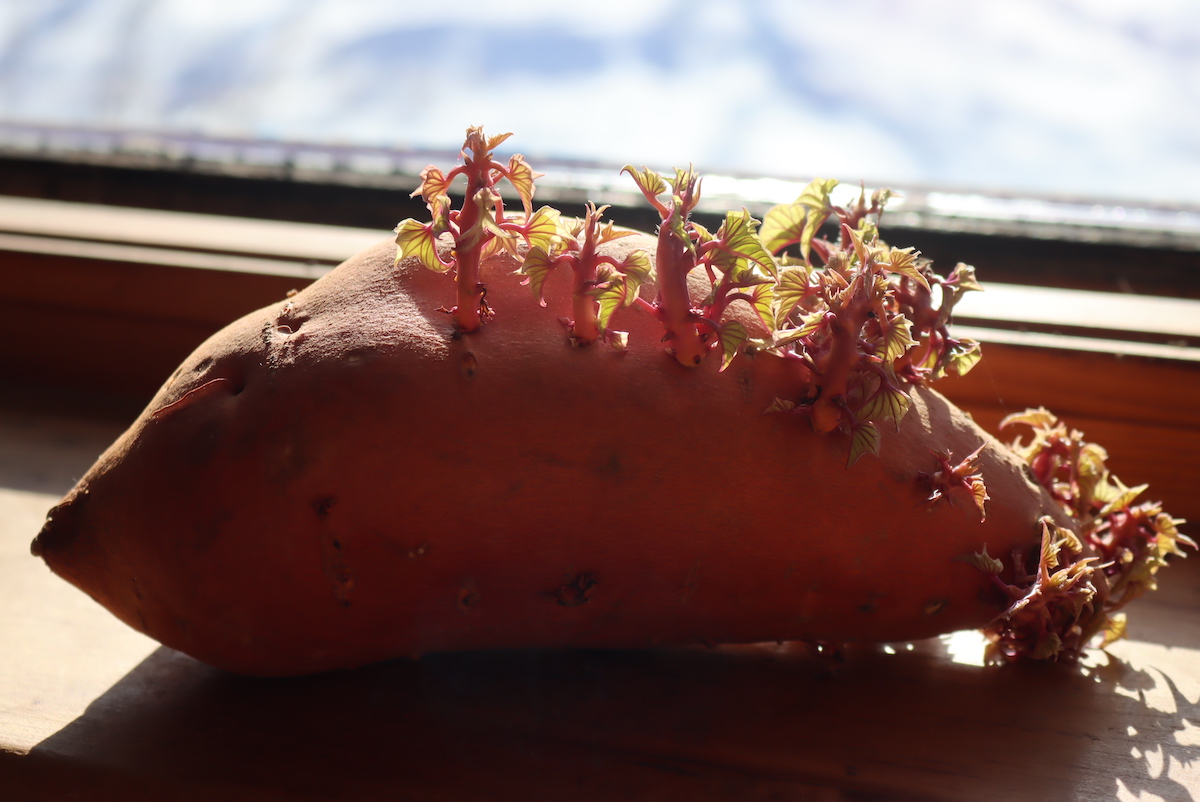
Tips for Getting Sweet Potatoes to Sprout
You may have trouble sprouting sweet potatoes if you live in a particularly cool, dry climate. They need warmth and humidity to initiate growth.
A warm, active kitchen is a great place to encourage sprouting, since the extra humidity from cooking will help encourage them to sprout. Bathrooms are good spots for a similar reason.
You can also place the sweet potato in water, either a glass with the bottom tip just touching the liquid, or in a tray of water. I’ve had good luck placing the potatoes on seed starting flats without holes and adding just a bit of water. I then put those trays onto our seedling heat mats, which creates the perfect warm/humid conditions for sprouting.
A bit of sunlight also helps, especially once the sprouts start to form.
(I use the same DIY seed starting rack/lights that I use for microgreens in winter, and growing tomatoes from seed later on in the season.)
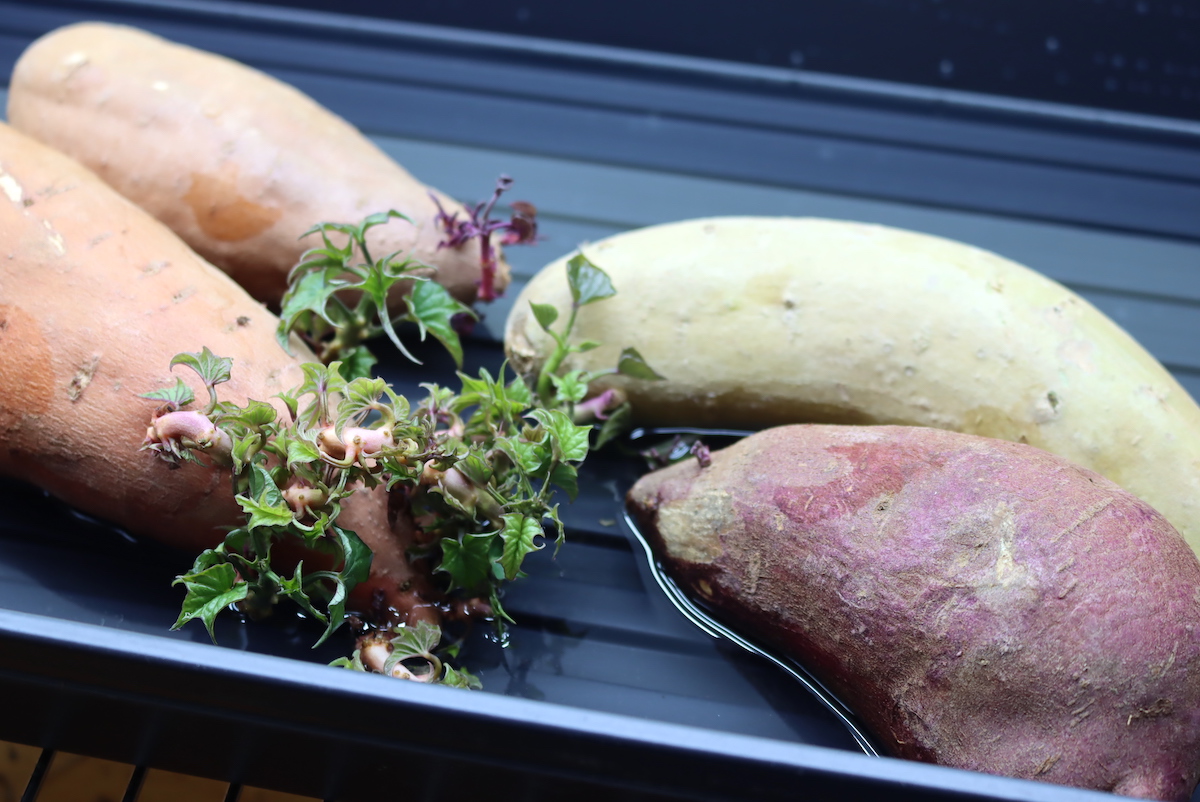
Growing Sweet Potato Slips
Once your sweet potatoes have sprouted, they need to be rooted before they’re actually full “sweet potato slips.”
Allow the sprouts to grow to about 2” (5 cm) long, and then carefully break them off where they attach to the sweet potato. Place that sprout into a cup of water and set it on a warm sunny windowsill.
Change the water every few days, and watch for roots. You should see roots in 1-2 weeks.
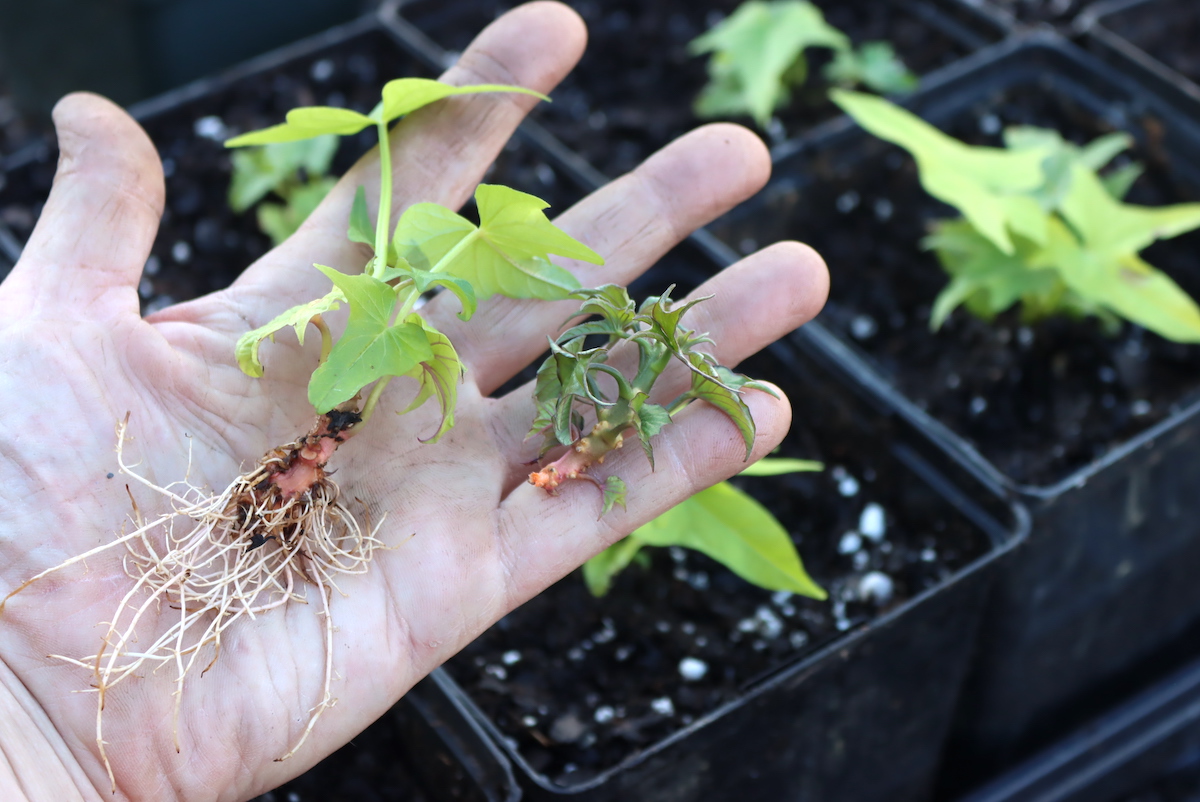
If the sweet potato is still firm and not beginning to spoil, you can keep it and encourage more sprouts. You should be able to get 6 to 20 slips from a single sweet potato, depending on size.
If the sweet potato starts to get squishy or spoiled, then it’s time to put it into the compost. Break off any sprouts, no matter how small, and try to root those without the sweet potato. Once the potato gets soft, then things get messy. It’s time to toss it even if the sprouts are quite small.
A single small cup can hold many sweet potato sprouts, just make sure it’s relatively shallow, or keep the sprouts supported. You only want the very bottom of each sprout in the water. If they’re too deep, they’re liable to mold rather than root.
Keep the leaves, and most of the stem, out of the cup and in sunlight.
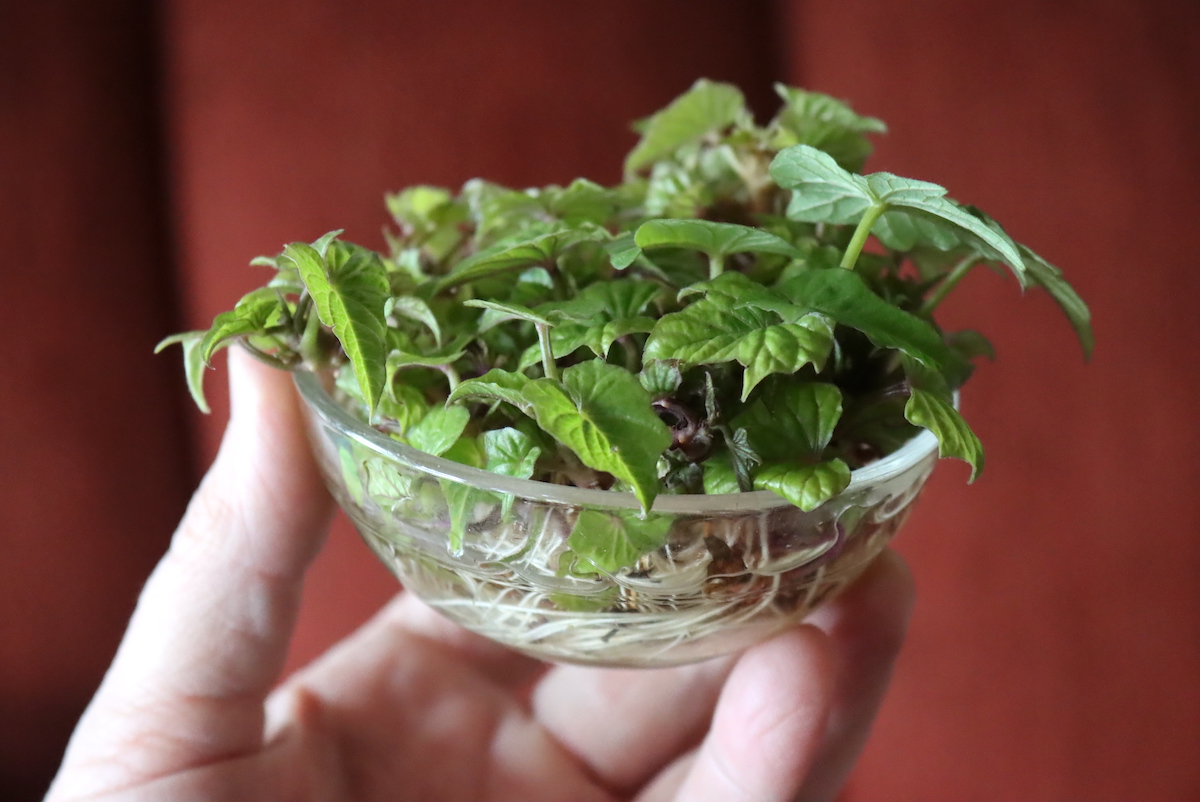
Planting Sweet Potato Slips
Once your sweet potato slips have several strong roots each, it’s time to get them in the soil.
I’ve you’ve started out late this season, and outdoor temperatures are already warm, you can just plant them outdoors. Be sure that you’re at least 2 weeks past your last frost date. We’re talking no chill in the air here, and warm sunny days. In Vermont, that’s not until mid-June but it’s in February in California…so decide based on your location.
While you can just plant them out, that’s not actually the best option. Ideally, you’ve started your sweet potato slips a bit early, and you still have about 4 to 8 weeks before outdoor planting time. This will give your sweet potato slips time to fully mature into small sweet potato plants indoors, which will give them a headstart on the season.
It’s kind of like tomato starts. Sure, you could plant them out as soon as they germinate (at 2” tall), but they’ll be better off if you let them mature into small plants first.
In the meantime, the rooted sweet potato slips need soil and nutrients, as well as light. We plant each one in a 4” pot with good quality potting soil, and place them on our seed starting rack with grow lights. Lacking grow lights, a sunny windowsill will work too.
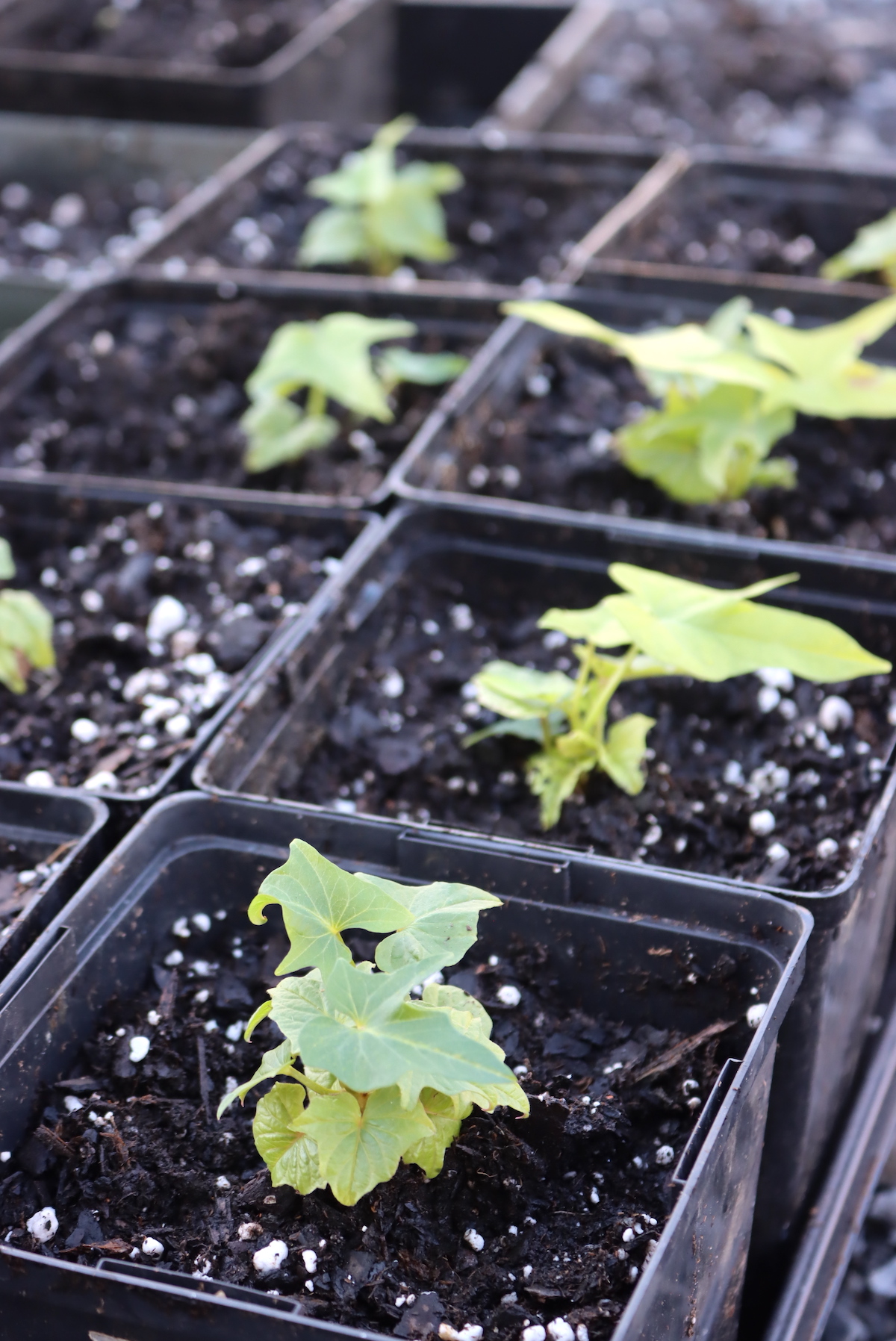
If you notice yellowing leaves while they’re developing, a liquid seaweed fertilizer will help keep them healthy and nourished until they reach garden soil. Amending their potting soil with compost also helps.
After a few weeks, the sweet potato slips will have grown into good-sized plants and they’ll be ready to plant outdoors. At this point, they’ll be starting to vine across each other and they’ll be happy for more space.
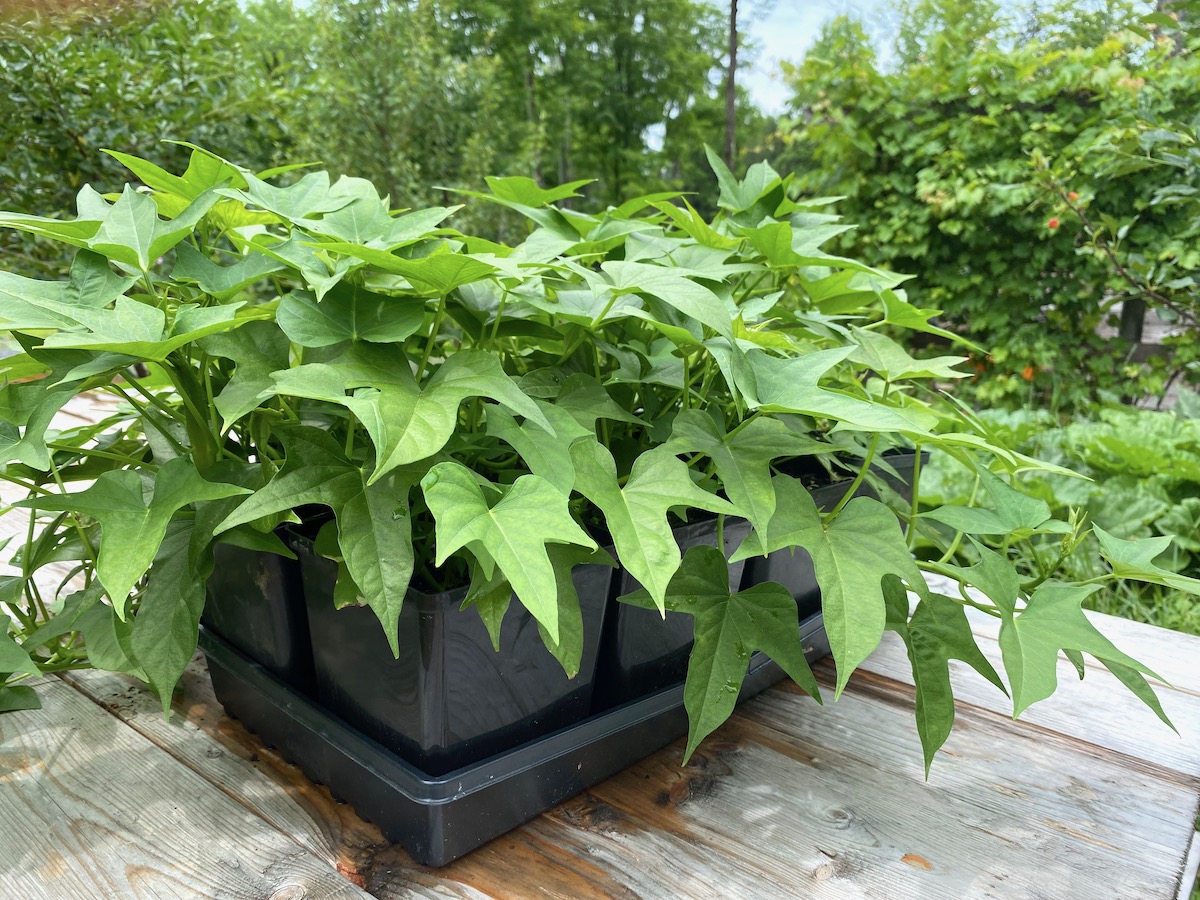
It can be helpful to harden off your young sweet potato plants before planting, especially if they haven’t been exposed to enough light indoors. Bring them outside for a few hours each day in the week leading up to their planting time to help acclimate them to bright sunlight.
When planting outdoors, be sure to choose a spot with full sun and plenty of soil nutrients. Since they like warm soil temperatures, we tend to plant them in raised beds to help balance out our cool summer temps.
In warmer locations, right in the ground is perfectly fine, just be sure your soil is amended and has lots of organic matter.
Harvest sweet potatoes after the leaves start to yellow in the fall, before the first frost in your area. After harvest, store the potatoes in high heat (85 to 90 degrees F) for about 15 days to help them develop tough skins for storage.
Store sweet potatoes at room temperature, around 70 degrees (not in a root cellar). If you don’t have a good place to store them, then canning sweet potatoes is a great way to preserve them right on the pantry shelf.
(Keep in mind you will need a pressure canner, as they’re not safe for water bath canning. If you’re new to canning, please read my beginners guide to pressure canning before getting started.)
Sweet Potato Greens
Growing sweet potato slips is actually fun (and worth it) even if you don’t have any garden space. While homegrown sweet potatoes are delicious, I think the real treat is sweet potato greens.
While sweet potatoes, even high-quality organic heirloom sweet potatoes, can be purchased in the store or farmers market, there’s almost nowhere you can buy sweet potato greens.
Unlike regular potatoes where the plants are toxic, every part of the sweet potato plant is edible.
Many people grow them as houseplants, and they do make beautiful vines. You can snip off the greens periodically to add to salads or stir-fries.
If grown indoors on a sunny windowsill the plant will thrive even through the winter months, and I’ve harvested fresh sweet potato greens indoors in January even here in the north country. We just keep the plant in a warm spot (near-ish the woodstove) and make sure it’s near a south-facing window.
I always start a few extra sweet potato slips to keep indoors for greens.
They’ll actually produce sweet potatoes too, and over time they’ll consume all the soil in the pot and replace it with fresh sweet potatoes (even indoors). We had that happen once, and I went to repot our indoor sweet potato plant to find that there was only a scraping of soil on top and a solid mass of sweet potatoes below.
The picture below is a container-grown sweet potato after about 6 months. We let this one grow outdoors in the summer months and I’m just about to bring it indoors for the winter. I’ve taken it out of the pot, and I’ll break off that sweet potato for our kitchen before I re-pot it for the winter.
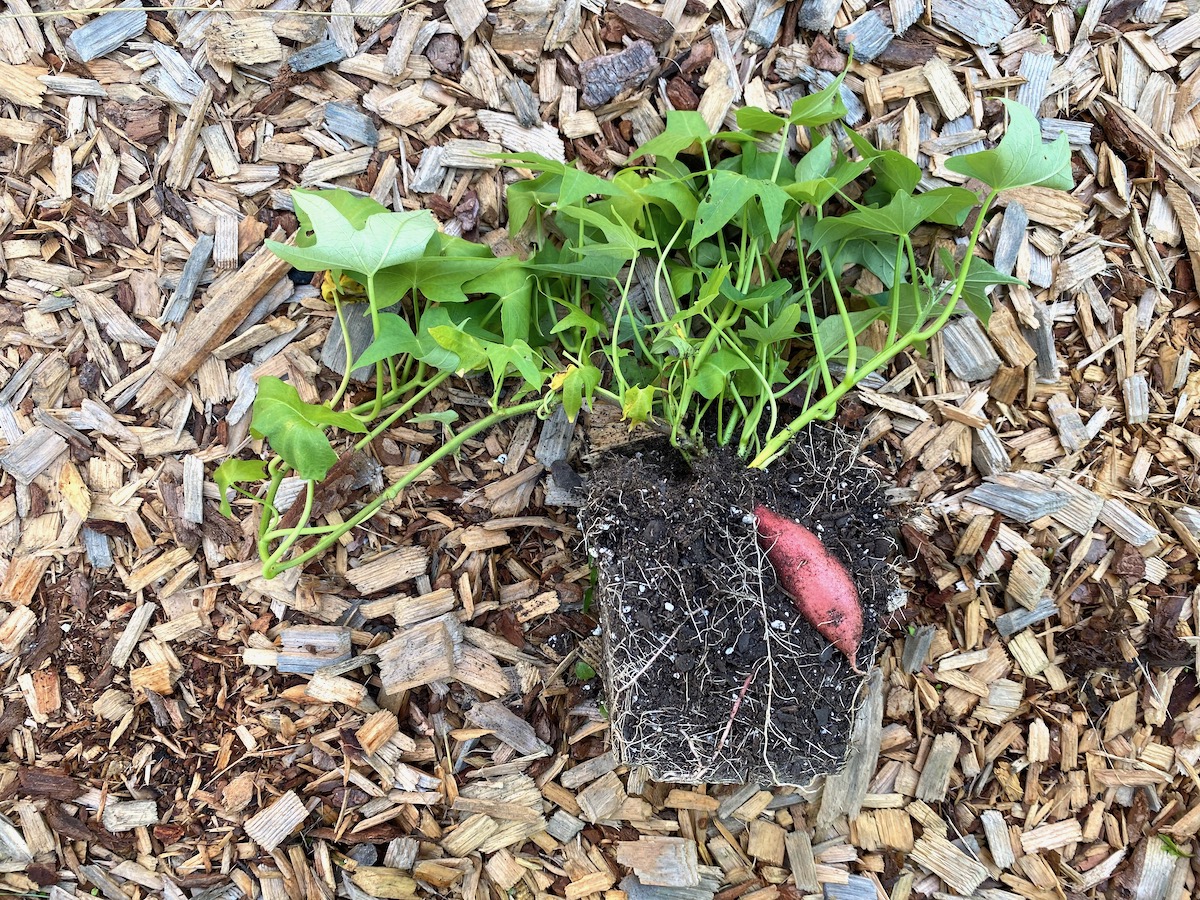
It’ll make more sweet potatoes, of course, even indoors. My real goal with this little one is the greens, and they’ll be plenty of those all winter long.
If you lack garden space, sweet potatoes do really well in containers too (as you can see). And when we’re short on garden beds I’ll plant them in large nursery pots (leftover from perennials) or in large grow sacks.
Something like a 5-gallon bucket with holes drilled in the bottom will work, but a large 20 gallon grow bag is even better. You’ll harvest plenty of sweet potatoes from those without any garden space.
Growing Guides
Looking for more growing guides to keep your garden lush and productive this season?
- Growing Everbearing Strawberries
- Growing Strawberries from Seed
- How to Plant Asparagus
- Growing Asparagus from Seed
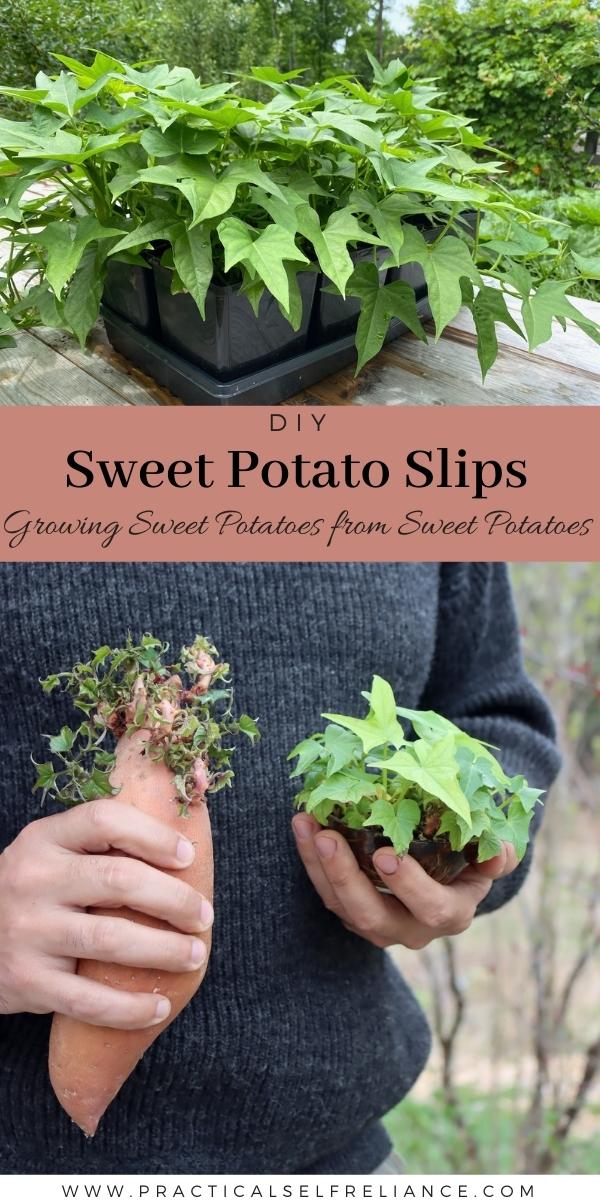
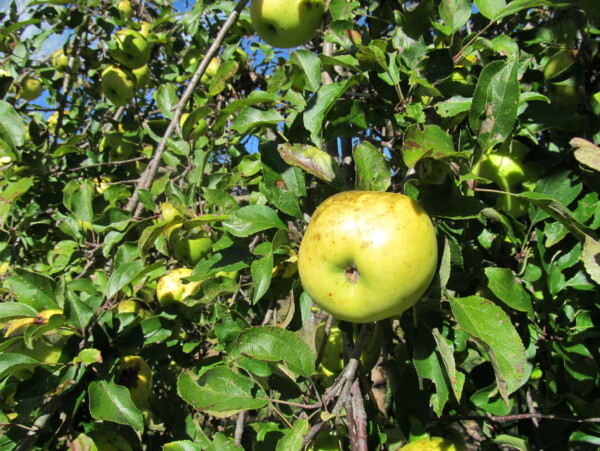













This is very clear and helpful. Thanks!
I love the information on sweet potato growing and planting.
Fantastic photos. This is pretty helpful. I love sweet potatoes both food and ornamental plants. I’ve grown them a bit in the past, but I think I’ll have better results next time with this information!
I hope it works out for you!
A very thorough instruction, thank you. Gonna see if I have some extra space in the house to deal with that sweet potatoes. Of course it is a fun, Same time the cost here in Brooklyn, NY stays between 69c – 99c per lbs and I’m not sure I like to consume sweet potato more than 10 lbs a year. If, for example, you grow several pigs and need a :free” food for them, in that case indeed sweet potato is a goo addition to their ration. After 60th we try to limit vegetable with starch consumption.
The greens are really quite lovely, and it makes a good houseplant. I actually like them more indoors as a houseplant that I can eat than planted out in the garden. It’s hard to really get sweet potatoes to thrive without really warm summer temps, which doesn’t really happen here in Vermont. They’ll produce for sure, but nothing like they do in the South.
Thanks Ashley for running this great article again… I am going to try this, soon as I can lay hands on an organic sweet potato. Appreciate your work. Keep spreading the love.
Thank you so much Becky!
Terrific article! I’m trying to grow sweet potatoes for the first time this year so the details in the article are incredibly helpful.
Wonderful, so glad it’s helpful to you!
Thanks for the reminders, Ashley! Will get some started asap this spring.
Wonderful! I’m so glad you’re going to try it =)
I have a seeet potato that sprouted. Some of the sprouts are 5-6 inch’s long but not really much in the way of leaves. Didn’t see it until it reached this point was stored in the pantry. I should be able to use those to get slips going.
Yes, they’ll work fine for slips. Once you expose them to light on a sunny windowsill they’ll start growing leaves and you’ll be all set. Good luck!
My grandson & I love growing sweet potatoes.
The vines are our favorite parts. We do enjoy the fleshy tubers also. We are going to give the greens a try. I’m sure they’ll be delicious too.
I really enjoy the way you present your ideas. The knowledge that you’ve shared has helped us in every part of our sweet potato journey.
You’d be a wonderful school teacher.
The piece you’ve written is very interesting to read.
Thank you for sharing this interesting and important information with us.
Monica & Thom (Nana & grandson 🥰)
You’re very welcome. Thanks for sharing. We’re so you enjoyed the post.
I have been trying to get slips since February from every organic sweet potato available in the markets in my town but, oddly, no luck… This has never happened before. They simply do not sprout or put out roots! Any ideas about what it could be caused by?
What method are you using to root the slips.
I save vines from the previous season. Potted up on my sun porch.
I thought you were trying to grow slips from sweet potatoes from town?
No I’ve kept the same ones going, growing them up from last year’s vines.
But I thought you said you were having trouble growing slips. I’m sorry but I guess I’m not sure exactly what your original question is about.
I’m not the original poster. I was just responding.
I’m so sorry. I see that now. I was so confused.
I think Betsy was try to leave a helpful hint for Chava? I know I’ll be saving some of my vines for next year as well. Thanks!
Yes, you’re right. Thank you so much for pointing that out.
This was outstanding. Your posts are always so detailed and rooted in fact and good personal experience. They’re so valuable and even if they don’t apply to my situation, informative and interesting.
I started sprouting some insanely expensive purple sweet potatoes. They’re tall and have tons of roots and I need to get them out of the water and wasn’t sure if I should pot them up until the beds are ready and the temps are right. Questions answered.
I had no idea about the edible leaves or keeping a perpetual plant-absolutely doing both from now on.
Thanks so much for sharing and all the effort you put into the content.
You’re very welcome. So glad you enjoyed the post.
I started my sweet potatoes in water and they sprouted. However, the sprouts are tiny little nubs and it doesn’t seem like they are growing any longer. It’s been a couple weeks and I can’t detect any noticeable growth. I have them in a sunny windowsill and change the water every 4-5 days. Any ideas why it seems like the grow has stunted? Or, maybe I’m being impatient. Thank you!
How long have they been sprouting?
Hi Amy, Have you ever tried growing white sweet potatoes that you see from time to time in the (none organic) grocery store? I’d like to try but wonder if the season would be too long for Vermont (4B zone)? I’m in Royalton, VT
You should be able to grow any variety of sweet potato as long as you get them started inside soon enough.
I am trying to grow slips and it just isn’t working I tried 3 of them in water and they just rotted. I am trying 3 more ways I cut one longways put it in water the other in soil also cut one in half and put it in water if none of the work. I will give up’
There are some sweet potatoes that are treated with germination inhibiting chemicals that will keep them from sporting. Other than that if they have warmth and humidity they should not have any trouble sprouting.
I love this very complete description of starting sweet potatoes. I wonder if you have ever tried over wintering the vines? I’m on my second year doing this and in spite of aphid and white flies, have good plants to use as starts this spring. I do have a surprising development: one of them just bloomed! Reminding me that they are the morning glory family. Why haven’t my vines ever bloomed in the garden, I wonder? …and will this plant make tubers?
We have overwintered the vines, and kept them as an edible houseplant for many years. They thrive and got huge, so we harvested plenty of greens, but our never flowered indoors.
Thank you for this post. My sweet tater started growing but was leery as I’ve never heard of anyone growing them where I live (zone 2b). Well I’m going to try it. My slips are rooting and I’m in search of a large grow container. I’m not going to try them in the ground, this year, maybe next after I’ve managed to make a suitable spot for them.
So excited to try this.
Question though, my one sweet tater has (had) 3 5″ slips on it and was developing a sugary white bumpy coating on the leaves. Not bugs but I’m thinking sugars? I’ve broken off the slips and placed them in water per your instructions above. We’ll see, what an adventure!
I don’t believe I have seen anything like that before. If you find out what it is please come back and share.
I’m going to go with my starch / sugars theory. I popped the slips off and put them in a shallow bowl with a bit of water just as instructed above. Wow, you can practically watch the roots grow. The white sugary substance is gone from the leaves and I’m going to assume it was absorbed and transferred to root growth.???
My sweet tater is still producing slips so I’m going to try and recreate this effect and get pictures. Fascinating experiment if nothing else. And how much fun is this!
That’s wonderful. Thank you so much for sharing.
Ashley, thank you for this very informative and interesting article! I’m going to get busy today doing what you recommend. I’m especially excited to try the greens. Do you have a store? I feel like I want to buy something from you to support your work, because you do such a good job. I’m a long time fan! You’re my go-to.
You’re very welcome. We’re so glad that you are enjoying the blog. Just keep reading and sharing. We don’t have an online store at this time but many of the articles do contain affiliate links which help to provide an income.
Excellent! I learned a lot from this DIY narrative on sweet potatoes. And it came just in time for my region. Thank you for sharing this “how to.”
You’re very welcome. So glad you enjoyed it.
Thank you Ashley, you are such an inspiration! I’m going to grow these in my sunroom, they will make a wonderful edible houseplant and if I start now I’ll have some to plant outside this year. I can’t wait to try sweet potato greens! Your articles are the best I’ve found on interesting, original, self-reliant projects to try, Thank you!
Wonderful, so glad it’s helpful to you! (And they really are delicious, either raw or cooked like kale.)
I would really appreciate this in a printable form to refer back to.
Thank you, Pam
The best way to print it is to just copy and paste it into a new document and then print it from there.